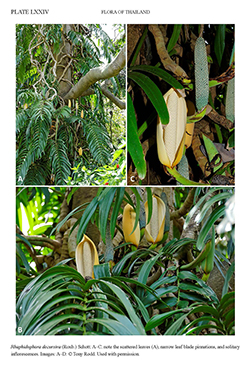e-Flora of Thailand
Volume 11 > Part 2 > Year 2012 > Page 271 > Araceae > Rhaphidophora
4. Rhaphidophora decursiva (Roxb.) Schott
Bonplandia (Hannover) 5(3): 45. 1857; Prodr. Syst. Aroid.: 385. 1860; Engl. in A.DC. & C.DC., Monogr. Phan. 2: 246–247. 1879; Hook.f., Fl. Brit. India 6: 547–548. 1893; Engl. & Krause in Engl., Pflanzenr. IV, 23B (Heft 37): 52. 1908; Gagnep. in Lecomte, Fl. Indo-Chine 6: 1099. 1942; V.D.Nguyen. Araceae. Checkl. Plant. Sp. Vietn. 3: 891. 2005; Li & Boyce in H.Li. et al., Fl. China 23: 14. 2010.— Pothos decursivus Roxb., Fl. Ind. 1: 456. 1820.— Monstera decursiva (Roxb.) Schott, Wiener Z. Kunst 4: 1028. 1830.— Scindapsus decursivus (Roxb.) Schott in Schott & Endl., Melet. Bot.: 21. 1832. Plate LXXIV.
Accepted Name : This is currently accepted.
Synonyms & Citations :
Description : Very large, often enormous, very robust, pachycaul, heterophyllous secondary hemiepiphyte to 20 m or more. Stem robust, 3–5 cm diam., terete. Leaves scattered, each foliage leaf separated from the next by several (up to 7) nodes bearing cataphylls; petiole shallowly canaliculate, 20–40 cm, pulvinus indistinct; petiolar sheath extending ⅔ along the petiole, margins soon marcescent; leaf blade (juvenile) blade rotund, entire, 16 by 13 cm, apex abruptly acute; (adult) oblong-ovate, ovate in outline, irregularly and asymmetrically pinnately cut with the incisions reaching the midrib and individual pinnae separated by a portion of naked midrib, 60–100 by 40–50 cm, pinnae 9–15 per side, those at the mid-leaf 3–5 cm wide, apex truncate with ascending falcate tip, base narrowed, 20 by 3–5 cm, with a strong costa, deep lustrous green adaxially, pale green abaxially. Inflorescence solitary or occasionally paired on tips of lateral shoots; peduncle cylindrical, very robust, 11–20 by 1.5–3 cm, green; spathe oblong-ovate, cymbiform, 17–20 by 10–12 cm, creamy yellow both sides, the lower exterior often deep yellow; spadix cylindrical, 15–16 by 2–3 cm, sessile, base oblique, creamy white; stylar region greyish-green-white sloughing to reveal white or yellow pulp cavity. Infructescence 15–20 by 5–5.5 cm, grey-green. Fruit hexagonal-obconical, 18 by 5 mm, apex with a persistent style.
Thailand : NORTHERN: Chiang Mai, Nan; NORTH-EASTERN: Loei, Nong Khai.
Distribution : Nepal and NE India (type and types of Rhaphidophora affinis, R. eximia, and R. insignis) through Bangladesh to SW China, Vietnam and Laos.
Ecology : Subtropical and warm temperate mixed upper hill to lower montane broad-leaf forests; 350–1,800 m alt.
Vernacular : Tueng khruea (ตึงเครือ)(Northern).
Notes: Rhaphidophora decursiva is most similar to R. glauca but can be distinguished by its more massive size, by the larger leaves (100 by 50 cm vs 42 by 24 cm) that are glossy pale green beneath, (vs glaucous), the leaf divisions reaching the midrib in adult plants such that each pinna is separated from the next by a naked sinus along the midrib, and the larger spadix (15–16 cm vs 4.5–8.5 cm).
Rhaphidophora grandis Schott, long considered a synonym of R. decursiva has been convincingly shown to be a distinct, separate species (see Noltie, Flora of Bhutan), separated most readily by the very much wider, truncate-tipped pinnae. It is yet to be recorded further east than Bhutan, but may conceiveably be present in NW Thailand.

